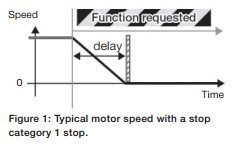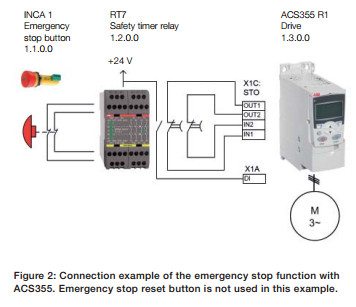ABB ACS355 Emergency Stop
 ABB ACS355 emergency stop is usedfor applications that require risk reduction from unexpected and hazardous movement. The aim to integrate drive-based safety functions is to createmachines that are safe to use. This safety function example is presented to install ABB ACS355 emergency stop but these same functions can be implemented with other ABB drives with few modifications. ACS355 machinery drives offer a safe torque off (STO) safety function as a standard integrated feature. STO eliminates the need to use contactors, which means that the drive is not disconnected from the power during safe stopping. This again enables fast restart of the drive and the machine. STO is also offered as standard in many ABB drive types for easy integration of functional safety.
ABB ACS355 emergency stop is usedfor applications that require risk reduction from unexpected and hazardous movement. The aim to integrate drive-based safety functions is to createmachines that are safe to use. This safety function example is presented to install ABB ACS355 emergency stop but these same functions can be implemented with other ABB drives with few modifications. ACS355 machinery drives offer a safe torque off (STO) safety function as a standard integrated feature. STO eliminates the need to use contactors, which means that the drive is not disconnected from the power during safe stopping. This again enables fast restart of the drive and the machine. STO is also offered as standard in many ABB drive types for easy integration of functional safety.
Overview of the Safety Function
ABB ACS355 emergency stop, stop category 1 (Figure 1), stops the drive with a controlled deceleration ramp before disabling the drives output to the motor. In this example, the deceleration ramp is time monitored. The safety function can be used in an application where a synchronized stop of multiple axes is required.
Design of the Safety Function
 The design of theABB ACS355emergency stop consists of an emergency stop button as an activating switch, a safety timer relay as a logic unit and a safe torque off (STO) -circuit inside the ACS355 drive. The drive acts as an actuator to bring the motor into a nontorque state after the deceleration. See circuit diagram (Figure 2) for connection details.
The design of theABB ACS355emergency stop consists of an emergency stop button as an activating switch, a safety timer relay as a logic unit and a safe torque off (STO) -circuit inside the ACS355 drive. The drive acts as an actuator to bring the motor into a nontorque state after the deceleration. See circuit diagram (Figure 2) for connection details.
Operation of the safety function When the emergency stop button is pressed, the safety relay detects the button signal and opens its non-delayed contacts to inform the drive todecelerate. Simultaneously, the relays timer for the time delay contacts starts counting. After the time delay has elapsed, the contacts open, activating the STO function, which disables the drives power output to the motor. To continue drive operation after an emergency stop, the emergency stop button is released (pulled up), which causes the contacts of the relay to close. This deactivates the STO function. The drive is restarted by a separate start command. The drive is configured not to start automatically.
The safety relay is used to provide diagnostics for the emergency stop button wiring. The relay also enables the use of a separate reset button, if required (reset button is not shown in this example since it is not required by the standard). Ensuring the required safety performance The safety function has to fulfil the required safety performance determined by a risk assessment. ABBs Functional safety design tool (FSDT-01) is used to design the desired safety function.
This is carried out according to the Following Steps:
1. Evaluate the risks to establish target safety performance (SIL/PL level) for the safety function.
2. Design the safety function loop and verify the achieved performance (PL) or safety integrity level (SIL) for the safety function loop (according to EN ISO 13849-1 or EN/IEC 62061, respectively), utilizing the device safety data and the application specific characteristics.
3. Generate a report for the machine documentation. Report should contain all the calculation results as well as all assumptions made during the application design.
Safety function verification and validation In addition to the safety calculations for the achieved safety performance (SIL/PL), the safety function needs to be functionally verified as well. Finally the implemented safety function is validated against the risk assessment to ensure that the implemented safety function actually reduces the targeted risk.
General considerations Achieving machinery safety requires a systematic approach beyond the physical implementation of a safety function. The overall machinery safety generally covers the following areas:
- Planning for and managing functional safety during the life cycle of the machine
- Assuring compliance to local laws and requirements (such as the Machinery directive/CE marking)
- Assessing machine risks (analysis and evaluation)
- Planning the risk reduction and establishing safety requirements
- Designing the safety functions
- Implementing and verifying the safety functions
- Validating the safety functions
- Documenting the implemented functions and results of risk assessment, verification and validation
For more information concerning the ABBACS355 emergency stop function, visit the ABB Website.For ABB drive repair quotes or ABB drive replacement quotes, contact Precision Electric.







